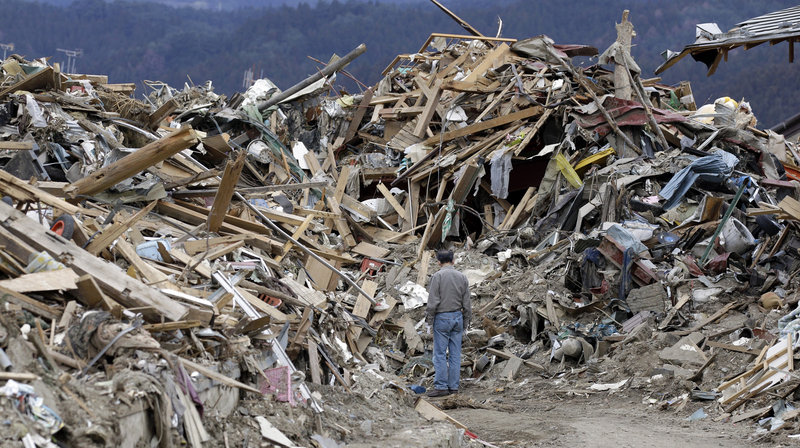Workers began pumping more than 3 million gallons of contaminated water from Japan’s tsunami-ravaged nuclear plant into the Pacific Ocean on Monday, freeing storage space for even more highly radioactive water that has hampered efforts to stabilize the reactors.
It will take about two days to pump most of the less-radioactive water out of the Fukushima Dai-ichi nuclear complex, whose cooling systems were knocked out by the magnitude-9.0 earthquake and tsunami March 11.
Radioactivity is quickly diluted in the ocean, and government officials said the dump should not affect the safety of seafood in the area.
Since the disaster, water with different levels of radioactivity has been pooling throughout the plant. People who live within 12 miles have been evacuated and haven’t been allowed to return.
The pooling water has damaged systems and the radiation hazard has prevented workers from getting close enough to power up cooling systems needed to stabilize dangerously vulnerable fuel rods.
On Saturday, they discovered that some radioactive water was pouring into the ocean.
The less-radioactive water that officials are purposely dumping into the sea is up to 500 times the legal limit for radiation.
“Releasing water with low levels of radiation is preferable to allowing water with high levels of radiation to be released into the environment,” said Junichi Matsumoto, an official with plant operator Tokyo Electric Power Co.
Workers need to get rid of the highly radioactive water, but first they need somewhere safe to put it. Much of the less-radioactive water being dumped into the sea is from the tsunami and had accumulated in a nuclear waste storage building.
The building is not meant to hold water, but it’s also not leaking, so engineers decided to empty it so they can pump in the more-radioactive water. The rest of the water going into the sea is coming from a trench beneath two of the plant’s six reactors.
More water is pooling because TEPCO has had to rely on makeshift methods of bringing down temperatures and pressure by pumping water into the reactors and allowing it to gush out wherever it can. Though messy, the process is preventing a full meltdown of the fuel rods that would release even more radioactivity into the environment.
“We must keep putting water into the reactors to cool to prevent further fuel damage, even though we know that there is a side effect, which is the leakage,” said Hidehiko Nishiyama, a spokesman for Japan’s Nuclear Safety and Industrial Agency.
“We want to get rid of the stagnant water and decontaminate the place so that we can return to our primary task: to restore the sustainable cooling capacity as quickly as possible.”
Engineers have been using unusual methods to try to stop the more highly radioactive water leaking into the sea.
They thought it was coming from a crack in a maintenance pit they discovered Saturday, but an attempt to seal the crack with concrete failed, and clogging it with a special polymer mixed with sawdust and shredded newspapers didn’t work, either.
They dumped white bath salts into the system around the pit Monday to try to figure out the source of the leak, but it never splashed out into the ocean.
In the meantime, workers plan to install screens made of polyester fabric to try to stop some of the contamination in the ocean from spreading.
Although the government eventually authorized the dumping of the less-radioactive water, Chief Cabinet Secretary Yukio Edano said officials were growing concerned about the sheer volume of radioactive materials spilling into the Pacific. It is not clear how much water has leaked in addition to what is being dumped purposely.
“Even if they say the contamination will be diluted in the ocean, the longer this continues, the more radioactive particles will be released and the greater the impact on the ocean,” he said. “We are strongly urging TEPCO that they have to take immediate action.”
Also Monday, a spokesman for the Russian nuclear agency Rosatom, Sergei Novikov, said that Moscow was considering a request from Japan to send it a vessel used to decommission nuclear submarines.
The crisis has unfolded as Japan deals with the aftermath of twin natural disasters that devastated much of its northeastern coast. Up to 25,000 people are believed to have died and tens of thousands lost their homes.
The situation at the Fukushima plant has raised questions around the world about the safety of nuclear power. Yukiya Amano, the head of the International Atomic Energy Agency, told delegates at a nuclear safety conference Monday that the industry cannot afford to ignore these concerns.
“We cannot take a business-as-usual approach,” Amano said.
General Electric CEO Jeff Immelt, who was in Tokyo this week to meet with TEPCO’s chairman, defended the industry when asked by a reporter if the Fukushima incident would cause global concern about nuclear safety.
“This is an industry that’s had an extremely safe track record for more than 40 years,” he said. “We have had more than 1,000 engineers working around the clock since the incident began and we will continue in the short, medium and long term working with TEPCO.”
All of the plant’s reactors were designed by GE, and Immelt offered assistance in dealing with the power shortage brought on by damage to the Fukushima Dai-ichi facility and other power plants.
Send questions/comments to the editors.



Comments are no longer available on this story